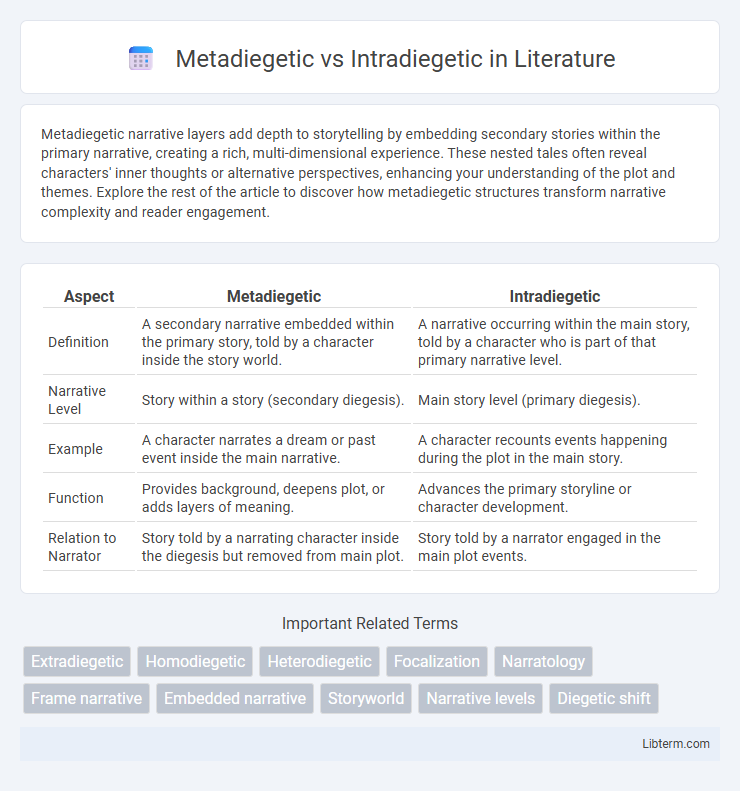Metadiegetic narrative layers add depth to storytelling by embedding secondary stories within the primary narrative, creating a rich, multi-dimensional experience. These nested tales often reveal characters' inner thoughts or alternative perspectives, enhancing your understanding of the plot and themes. Explore the rest of the article to discover how metadiegetic structures transform narrative complexity and reader engagement.
Table of Comparison
| Aspect | Metadiegetic | Intradiegetic |
|---|---|---|
| Definition | A secondary narrative embedded within the primary story, told by a character inside the story world. | A narrative occurring within the main story, told by a character who is part of that primary narrative level. |
| Narrative Level | Story within a story (secondary diegesis). | Main story level (primary diegesis). |
| Example | A character narrates a dream or past event inside the main narrative. | A character recounts events happening during the plot in the main story. |
| Function | Provides background, deepens plot, or adds layers of meaning. | Advances the primary storyline or character development. |
| Relation to Narrator | Story told by a narrating character inside the diegesis but removed from main plot. | Story told by a narrator engaged in the main plot events. |
Introduction to Diegetic Levels in Narratives
Metadiegetic and intradiegetic levels refer to layers within a narrative structure, where intradiegetic pertains to the primary story world and characters directly involved, while metadiegetic involves a story embedded within the primary narrative, often told by a character inside the original story. These diegetic levels help analyze how narratives organize storytelling by distinguishing between the main narrative frame and embedded sub-narratives. Understanding these concepts is crucial for examining complex narrative techniques in literature, film, and other media.
Defining Intradiegetic Narration
Intradiegetic narration occurs when the narrator exists within the story's primary narrative level, relaying events to which they have direct access or experience. This type of narration contrasts with metadiegetic narration, where the narrator recounts a story embedded within the primary narrative, often from a secondary or nested layer. Intradiegetic narration provides an internal perspective, offering insight into characters' thoughts, emotions, and subjective realities while maintaining the story's main temporal and spatial framework.
Understanding Metadiegetic Narration
Metadiegetic narration occurs when a secondary narrative is embedded within the primary narrative, with a storyteller inside the story recounting another tale. This layer of narration creates a distinct narrative level that can reveal different perspectives or deepen thematic complexity. Understanding metadiegetic narration helps analyze how stories are structured and how meaning is conveyed through multiple narrative frames.
Key Differences Between Intradiegetic and Metadiegetic
Intradiegetic narrators exist within the primary narrative level, directly participating in the story, while metadiegetic narrators operate within a secondary narrative embedded inside the primary one, often relaying a story within the story. The key difference lies in their narrative layers: intradiegetic narration occurs at the main diegetic level, whereas metadiegetic narration unfolds at a subordinate, embedded diegetic level. Intradiegetic narrators provide a perspective grounded in the primary narrative world, whereas metadiegetic narrators introduce a nested viewpoint, enriching narrative complexity through layered storytelling.
Narrative Functions of Intradiegetic Voices
Intradiegetic voices serve crucial narrative functions by providing perspective from within the story world, often revealing characters' inner thoughts, motivations, and subjective experiences. These voices enhance plot development through direct character narration or commentary, creating a layered storytelling effect that deepens audience engagement. By contrast, metadiegetic voices introduce nested narratives or stories within the primary diegesis, but intradiegetic narrators remain embedded in the original narrative layer, maintaining a coherent internal point of view.
The Role of Metadiegetic Narratives in Storytelling
Metadiegetic narratives function as stories within stories, allowing characters to become narrators and adding layers of meaning to the primary plot. These embedded tales provide deeper psychological insights and enhance thematic complexity by reflecting on or contrasting with the main narrative. The metadiegetic perspective enriches storytelling by creating a multidimensional experience that engages audiences through nested narrative structures.
Examples from Literature: Metadiegetic vs Intradiegetic
Metadiegetic narratives occur when a story is told within another story, such as the embedded fairy tales in "The Canterbury Tales" by Geoffrey Chaucer, where characters narrate their own tales inside the main narrative. Intradiegetic narrators exist within the story world itself, like Nick Carraway in F. Scott Fitzgerald's "The Great Gatsby," who participates in and recounts the events firsthand. The distinction highlights varying narrative layers and perspectives, enriching textual complexity and reader engagement in literary analysis.
Impact on Reader Perception and Engagement
Metadiegetic narratives create layers within the story by embedding a secondary narrative inside the primary diegesis, which deepens reader engagement through complex temporal and spatial shifts, enhancing interpretive immersion. Intradiegetic narration, confined to the primary narrative level, fosters direct reader identification with characters and events, increasing emotional resonance and clarity of storyline. The interplay between metadiegetic and intradiegetic perspectives enriches reader perception by balancing complexity with coherence, driving nuanced engagement and interpretive depth.
Analyzing Narratological Structures
Metadiegetic and intradiegetic levels in narratology define different layers of the narrative structure: intradiegetic refers to the story told within the primary narrative world, while metadiegetic denotes an embedded narrative nested within that story. Analyzing these layers highlights how narratives manipulate time, perspective, and character positioning to shape the reader's understanding and engagement. Distinguishing between these narratological structures allows scholars to explore the complexity of storytelling techniques and the functions of embedded tales within larger narrative frameworks.
Conclusion: Choosing the Right Diegetic Layer
Selecting the appropriate diegetic layer hinges on narrative goals and audience engagement strategies; metadiegetic layers enrich storytelling by embedding secondary narratives within the primary world, fostering complex interpretive experiences. Intradiegetic layers maintain story unity by keeping all events within the same narrative level, ensuring clarity and straightforward comprehension. Understanding the distinct functions of metadiegetic and intradiegetic layers enables creators to craft immersive and structurally coherent narratives that resonate effectively with their target audience.
Metadiegetic Infographic

 libterm.com
libterm.com